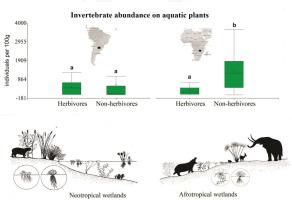Aquatic Botany ( IF 1.8 ) Pub Date : 2020-08-27 , DOI: 10.1016/j.aquabot.2020.103289 Celeste Franceschini , Kevin J. Murphy , Michael P. Kennedy , Fedra S. Martínez , Frank Willems , Henry Sichingabula

|
In this study we assessed the abundance and composition (taxa and feeding guilds) of invertebrate communities occurring on 11 aquatic plant species in Neotropical and Afrotropical wetlands. We tested the hypothesis that invertebrate herbivores form only a minor component of the invertebrate assemblages associated with freshwater macrophytes. The waterbodies experienced differing intensities of disturbance pressure (grazing, trampling, sediment disturbance) from large mammalian herbivores. General analysis of macrophyte samples collected during 2012–2013 from Zambia and Argentina showed that in Afrotropical wetlands invertebrate herbivores were significantly less abundant than non-herbivorous invertebrate taxa. In the Neotropical wetlands, the abundance of herbivorous and non-herbivorous invertebrate taxa did not differ significantly. Analysis per macrophyte species showed that invertebrate herbivores occurred in higher or similar abundance compared to non-herbivores in 83 % of macrophyte species in the Neotropics, but only in one macrophyte species in the Afrotropics. Taxa and feeding guilds of invertebrate herbivores varied between macrophyte species and ecozones, but were dominated by semiaquatic insects. TWINSPAN analysis of the plant samples hosting invertebrate morphospecies (n = 91) produced a sample-classification of four sample groups, with substantial differences in invertebrate morphospecies associated with each group of plant samples. The results show that invertebrate herbivores, mainly insects, are both numerically important and likely to form an important component of nutrient-cycling processes involving macrophyte biomass in warm-water wetlands. Whether the differences observed between the two ecozones are related to differences in large-herbivore presence, or to other inter-ecozone biogeographical differences in habitat conditions, or both, remains an issue for further research.
中文翻译:

在热带湿地中,淡水大型植物的无脊椎动物草食动物稀少吗?
在这项研究中,我们评估了在新热带和非热带湿地中11种水生植物物种上无脊椎动物群落的数量和组成(分类和进食行会)。我们检验了无脊椎动物草食动物仅形成与淡水大型植物相关的无脊椎动物组合中的一小部分的假设。水体经历了来自大型哺乳动物食草动物的不同干扰压力强度(放牧,践踏,沉积物干扰)。对2012-2013年期间从赞比亚和阿根廷收集的大型植物样品的一般分析表明,在非热带湿地中,无脊椎动物食草动物的丰富度明显低于非食性无脊椎动物分类单元。在新热带湿地中,草食性和非食性无脊椎动物分类单元的丰度没有显着差异。对每种大型植物物种的分析表明,新热带地区83%的大型植物物种中无脊椎动物食草动物的丰度高于非草食性动物,而在非热带地区只有一种大型植物。在大型植物物种和生态区之间,无脊椎动物草食动物的分类单元和进食行会有所不同,但以半水生昆虫为主。对容纳无脊椎动物形态种的植物样品(n = 91)进行TWINSPAN分析得出四个样品组的样品分类,与每组植物样品相关的无脊椎动物形态种之间存在实质性差异。结果表明,无脊椎动物的草食动物(主要是昆虫)在数值上既重要,又可能构成涉及温水湿地大型植物生物量的养分循环过程的重要组成部分。


























 京公网安备 11010802027423号
京公网安备 11010802027423号